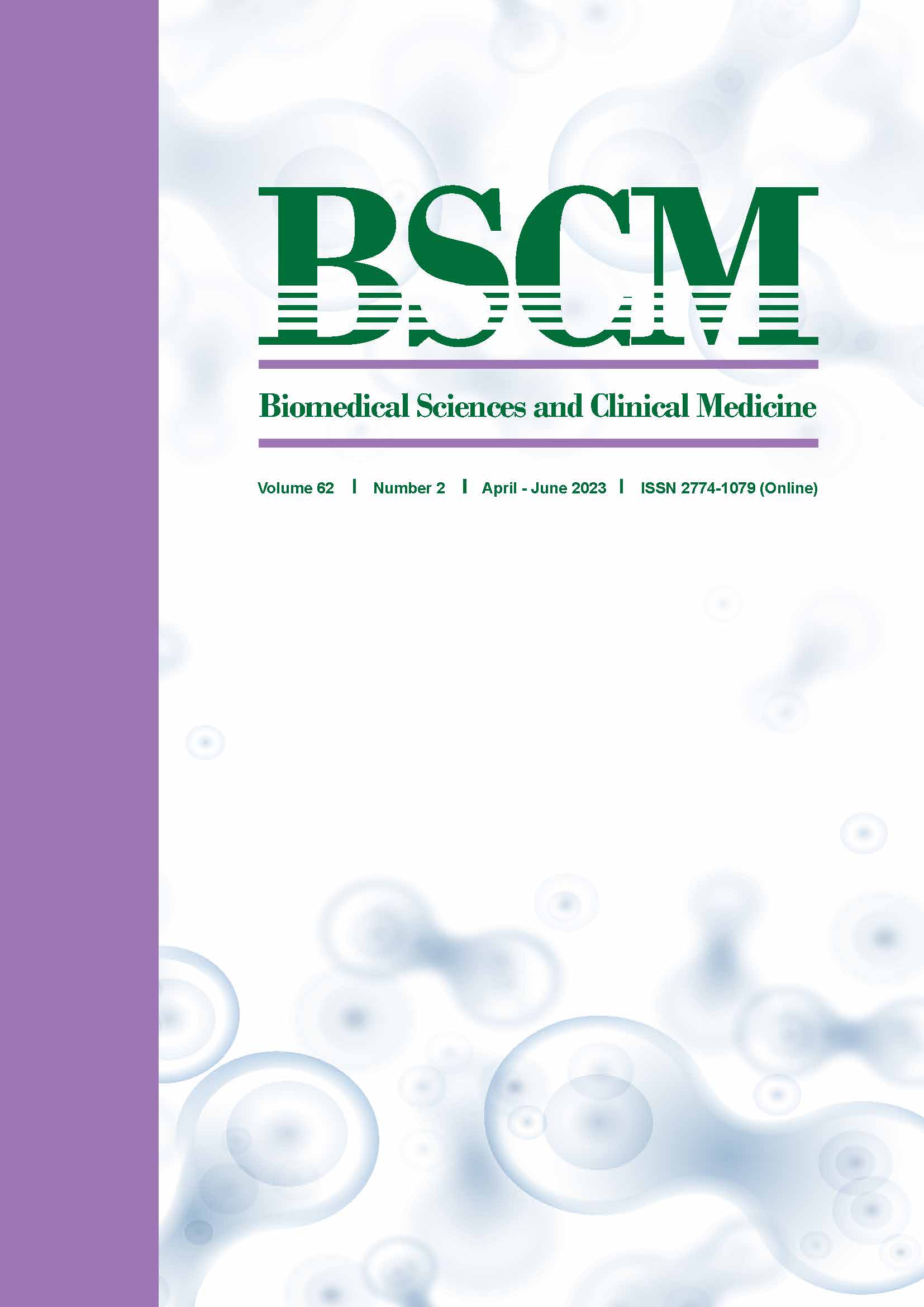Planning Target Volume Margin Determination for Volumetric Modulated Arc Therapy Planning in Cervix Cancers Using an Empty Bladder Protocol
Main Article Content
บทคัดย่อ
Objective To evaluate the planning target volume (PTV) margin and bladder volume variation of volumetric modulated arc therapy (VMAT) in cervical cancer using an empty bladder protocol.
Methods Ten patients with cervical cancer who had indications to receive whole pelvic radiotherapy and who had been identified to receive whole pelvic irradiation with a dose of 46-55.2 Gy in 23 fractions planned by VMAT were included. International Commission on Radiation Units and Measurements (ICRU) Report 83 was used to report plan parameters. The empty bladder protocol is designed for use with all patients before simulation and irradiation. From June 2020 to February 2021, 215 fractions from the 10 patients were evaluated. The ‘all fraction’ set-up errors were recorded using cone-beam computed tomography (CBCT) and were interpreted as error margins using the Van Herk Formula.
Results The calculated PTV margins were 0.75, 0.84, and 0.98 cm on the X, Y, and Z-axes, respectively. The median volume of the bladder before irradiation was 40.6 cc, with an interquartile range of 31.9 to 59.2 cc. The average change in bladder volume from the planning volume was 23.56%.
Conclusions Using the empty bladder protocol, the clinical target volume (CTV) to PTV margin was 1 cm following the Van Herk formula. No patients experienced side effects of grade 3 or greater. The empty bladder protocol is a method which can reduce target placement error and reduce patient discomfort without causing serious side effects.
Article Details

อนุญาตภายใต้เงื่อนไข Creative Commons Attribution 4.0 International License.
เอกสารอ้างอิง
Sung H, Ferlay J, Siegel RL, Laversanne M, Soerjomataram I, Jemal A, et al. Global Cancer Statistics 2020: GLOBOCAN Estimates of Incidence and Mortality Worldwide for 36 Cancers in 185 Countries. CA Cancer J Clin. 2021;71:209-49.
Bhatla N, Aoki D, Sharma DN, Sankaranarayanan R. Cancer of the cervix uteri: 2021 update. Int J Gynaecol Obstet. 2021;155 Suppl 1(Suppl 1):28-44.
Hodapp N. The ICRU Report 83: prescribing, recording and reporting photon-beam intensity-modulated radiation therapy (IMRT). Strahlenther Onkol. 2012;188:97-9.
Yeung AR, Pugh S, Klopp AH, Gil K, Wenzel L, Westin SN, et al. IMRT improves late toxicity compared to conventional RT: an update on NRG Oncology-RTOG 1203. Int J Radiat Oncol Biol Phys. 2019;105:S50.
Chopra S, Gupta S, Kannan S, Dora T, Engineer R, Mangaj A, et al. Late Toxicity after adjuvant conventional radiation versus image-guided intensity-modulated radiotherapy for cervical cancer (PARCER): a randomized controlled trial. J Clin Oncol. 2021;39(33):3682-92.
Ahmad R, Hoogeman MS, Bondar M, Dhawtal V, Quint S, De Pree I, et al. Increasing treatment accuracy for cervical cancer patients using correlations between bladder-filling change and cervix-uterus displacements: Proof of principle. Radiother Oncol. 2011;98:340-6.
Mahantshetty U, Naga P, Nachankar A, Ghadi Y, Dheera A, Scaria L, et al. Set-up errors, organ motion, tumour regression and its implications on internal target volume-planning target volume during cervical cancer radiotherapy: results from a prospective study. Clin Oncol. 2022;34:189-97.
Chen VE, Gillespie EF, Manger RP, Skerritt LA, Tran JH, Proudfoot JA, et al. The impact of daily bladder filling on small bowel dose for intensity modulated radiation therapy for cervical cancer. Med Dosim. 2019;44:102-6.
Chetiyawardana G, Hoskin PJ, Tsang YM. The implementation of an empty bladder filling protocol for localised prostate volumetric modulated arctherapy (VMAT): early results of a single institution service evaluation. Br J Radiol. 2020;93 (1114):20200548.
Grégoire V, Mackie TR. State of the art on dose prescription, reporting and recording in Intensity-modulated radiation therapy (ICRU report No. 83). Cancer Radiother. 2011;15:555-9.
Klopp AH, Yeung AR, Deshmukh S, Gil KM, Wenzel L, Westin SN, et al. Patient-reported toxicity during pelvic intensity-modulated radiation therapy: NRG oncology-RTOG 1203. J Clin Oncol. 2018;36: 2538-44.
van Herk M, Remeijer P, Rasch C, Lebesque JV. The probability of correct target dosage: dose-population histograms for deriving treatment margins in radiotherapy. Int J Radiat Oncol Biol Phys. 2000;47:1121-35.
Yeung AR, Pugh SL, Klopp AH, Gil KM, Wenzel L, Westin SN, et al. Improvement in patient-reported outcomes with intensity-modulated radiotherapy (RT) compared with standard RT: a report from the NRG oncology RTOG 1203 Study. J Clin Oncol. 2020;38:1685-92.
Ahmad R, Hoogeman MS, Quint S, Mens JW, de Pree I, Heijmen BJM. Inter-fraction bladder filling variations and time trends for cervical cancer patients assessed with a portable 3-dimensional ultrasound bladder scanner. Radiother Oncol. 2008;89:172-9.
Marks LB, Yorke ED, Jackson A, Ten Haken RK, Constine LS, Eisbruch A, et al. Use of normal tissue complication probability models in the clinic. Int J Radiat Oncol. 2010;76:S10-9.


